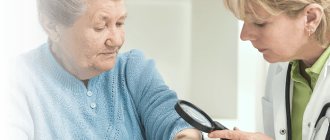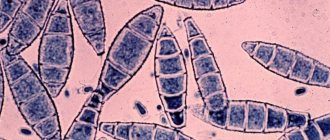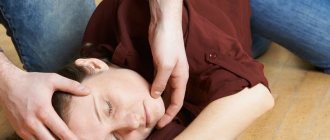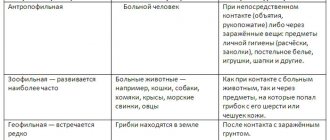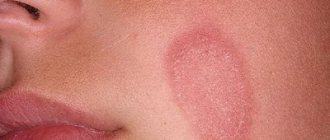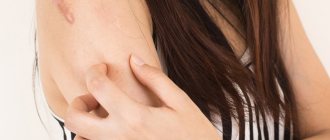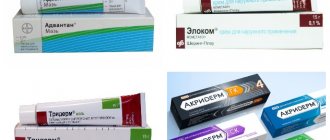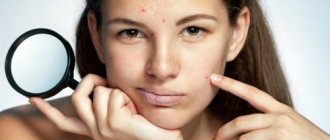Pityriasis versicolor or pityriasis versicolor is a superficial skin lesion caused by a yeast-like fungus of the genus Malassezia.
These microorganisms are representatives of typical skin microflora, are found in most people and do not cause the development of the disease. But under the influence of external or internal factors, the pathogen can transform from a non-pathogenic form into a pathogenic one: the fungus penetrates the upper layers of the skin and damages melanocytes - the cellular structures responsible for the pigmentation of the skin.
As a result, the patient develops small spots of different colors: from pale pink to red-brown, with noticeable peeling in the center. When touched, the scabs flake off easily and resemble flakes, which is what gives pityriasis versicolor its name.
What is pityriasis versicolor?
Pityriasis versicolor is a dermatological disease, most often diagnosed in people under the age of 30, while it is rare in children and the elderly. A predisposing factor to the occurrence of infection is often excessive activity of the sweat glands, so the disease often develops in the summer, at resorts and in countries with a humid, hot climate.
Lichen versicolor develops against the background of:
- chronic gastrointestinal diseases (gastritis, ulcers);
- endocrine disorders;
- autoimmune diseases;
- hormonal fluctuations, including those caused by taking oral contraceptives, pregnancy, infertility treatment;
- genetic predisposition.
Ringworm can be triggered by taking certain medications, for example, immunosuppressants, glucocorticosteroids. Uncontrolled drug therapy also often causes lichen.
A decrease in the body's natural defenses can also trigger the growth of fungal colonies.
This can lead to:
- recent serious illnesses, injuries or surgeries;
- severe vitamin deficiency;
- hypothermia of the body;
- stress;
- prolonged exposure to adverse factors (for example, work in hazardous industries, contact with chemicals and reagents);
- food poisoning;
- period of increased mental and physical stress;
- sudden climate change;
- alcohol abuse.
Among the external factors that cause tinea versicolor, wearing tight synthetic clothing in the hot season stands out. Artificial materials disrupt natural skin respiration, increase sweating, and irritate the upper layers of the skin. As a result, colonies of the fungus penetrate the epidermis and begin to actively multiply.
Therapy during pregnancy
Treatment of lichen during pregnancy becomes a serious problem, since most pharmacological drugs are prohibited from being used during pregnancy. Taking into account all the restrictions, pregnant women can use medications based on salicylic acid, sulfur, and tar.
Approved medications include:
- Pimafucin;
- Miconazole;
- Zinc ointment;
- Sulfuric ointment.
Starting from the second trimester, pregnant women can be treated with lichen using the drugs Mycospor, Lamisil, Clotrimazole.
It is strictly forbidden to use hormonal drugs Hydrocortisone, Sinaflan, Advantan, Elokom.
Any glucocorticosteroids during pregnancy can be used only as prescribed by a doctor and under his strict supervision. Folk remedies for the treatment of various forms of lichen can also be used after the permission of the attending physician. They contain medicinal plants that can provoke an allergic reaction and cause unexpected consequences on the part of the fetus.
What does pityriasis versicolor look like?
The first symptom of the disease is the appearance of small spots, most often localized on the torso, arms, scalp or external genitalia. The rash may be accompanied by mild itching or may not cause the patient any noticeable discomfort.
The rashes do not have a sharp outline, are not inflamed and do not swell. Initially they are pink in color, but gradually change shade: from pink-yellow to brown and red-brown. The number of spots increases: the fungus spreads across the skin, occupying more and more surface area of the body. The rash may appear on the hands, legs, face, but never affects the mucous membranes, palms or feet, which is due to the special structure of the epithelium in these areas.
The rashes can increase in diameter (up to several centimeters) and merge with each other. Peeling zones appear in the center - when you touch the spot, the scales easily peel off. An atypical form of pityriasis versicolor includes pityriasis alba, in which the affected areas completely lose their pigment (become white). In this case, there may be no peeling.
A distinctive feature of pityriasis versicolor is a disorder of skin pigmentation. Fungal colonies damage melanocytes, which are responsible for the production of melanin, the substance responsible for the color of the skin. Areas of hypopigmentation are especially noticeable during tanning: the epithelium damaged by yeast remains white. This effect can persist for a long time even after recovery.
Pityriasis versicolor is prone to a chronic course and frequent relapses.
To quickly recover and avoid the unpleasant consequences of the infection, it is recommended to consult a dermatologist at the first symptoms of the disease:
- the appearance of a pink or reddish rash;
- mild itching of the skin;
- a feeling of tightness and flaking in certain areas of the skin of the torso and arms.
Analogues of the drug
The active substance of the ointment and cream was created a long time ago and has been well studied. External products based on clotrimazole are produced in many countries. Russian pharmaceutical companies usually use petroleum jelly and mineral oil as a base, which significantly reduces the cost of finished drugs.
Analogs for the active substance:
| A drug | Clotrimazole content | Manufacturer | price, rub. |
| Clotrimazole-Acri ointment | 1 % | "Akrikhin" (RF) | 35 |
| Clotrimazole ointment | 1% | "Sintez" (RF) | 89-108 |
| Clotrimazole cream | 1% | Hyperion (Romania) | 75-89 |
| Clotrimazole cream | 1% | GlaxoSmithKline Trading (RF) | 157-180 |
| Cream Clotrimazole-Teva | 1% | Teva (Israel) | 168-194 |
| Clotrimazole vaginal cream | 2% | Esparma GmbH (Germany) | 208-250 |
It happens that the antifungal agent is not effective. The way out of this situation is to change the drug to an analogue from the same drug group, which has a similar mechanism of action and indications. Instead of Clotrimazole ointment and cream, you can use group analogues. Antifungal ointments and creams:
| A drug | Active substance | Manufacturer | price, rub. |
| Mycozon | Miconazole | Agio Pharmaceuticals (India) | 111 |
| Ecodax | Econazole | Unique Pharmaceutical Laboratories (India) | 157-175 |
| Fungoterbin | Terbinafine | "Nizhpharm" (RF) | 190-270 |
| Pimafucin | Natamycin | Leo Pharma (Denmark) | 310 |
| Nizoral | Ketoconazole | Johnson & Johnson (RF) | 420-443 |
| Mycospor | Bifonazole | Bayer Healthcare (Germany) | 475-493 |
Clotrimazole is part of the combination drug Candide B. The second component of this cream, the hormonal substance beclomethasone, has a strong anti-inflammatory and antiallergic effect. The cream is used to treat thrush, which is accompanied by pain and itching. The price of the drug is 430 rubles.
How is pityriasis versicolor transmitted?
Pityriasis versicolor is transmitted through household contact, but this is rare: the disease is not very contagious. The causative agent of pityriasis versicolor, a fungus from the genus Malassezia, is present on the skin of most people, but does not penetrate the epithelium and does not lead to the appearance of a rash. However, under the influence of various factors, yeast transforms into a pathogenic form and begins to destroy skin cells. This process can be triggered by various factors: from excessive sweating to endocrine disorders.
Despite the low contagiousness of this type of lichen, patients are advised to adhere to some recommendations:
- do not share bed linen or towels;
- do not wear other people's clothes;
- do not visit baths, saunas, public swimming pools.
You should also take special care to disinfect the patient’s underwear, clothing and hats: wash at high temperatures (possibly boiling), iron with a hot iron, use steam treatment.
Symptoms
The disease manifests itself in the form of spots on the skin.
First, several so-called maternal formations about 5 cm in size appear. Then, over the course of a week, a large number of similar spots of smaller sizes scatter throughout the body. The most vulnerable areas are the abdomen, shoulders and hips. Rashes are rare on the face and neck. All spots, both maternal and “baby” ones, have the same appearance: pink or with a yellowish tint, round in shape, flaky inside with a smooth rim. Often, apart from spots, this disease does not manifest itself in any way. Therefore, as soon as any characteristic formations are discovered on the body, you should immediately contact a special clinic to diagnose pityriasis rosea. Sometimes itching appears in the affected areas, and the lymph nodes on the neck and chin become enlarged. If a person’s immunity is severely weakened, severe fatigue, fever or general intoxication of the whole body appears. There are cases when the external manifestation differs from the usual: blisters or white nodules appear on the skin.
Is it possible to cure pityriasis versicolor?
With proper therapy, pityriasis versicolor is easily treated and goes away within 2-3 weeks. To do this, you need to make an appointment with a dermatologist, who will conduct an examination and prescribe additional tests.
As a rule, the diagnosis is established in the presence of a typical clinical picture, but to confirm it, the following analyzes and tests are performed:
- examination under a Wood's lamp: fungal colonies are illuminated;
- microscopic examination of the scraping: shows the presence of yeast;
- Balzer test using iodine-containing solutions.
A dermatologist may also prescribe histological studies, general blood and urine tests. Based on the results of the examinations, treatment tactics are developed.
Depending on the severity and severity of the infection and the symptoms of lichen, therapy includes:
- the use of external agents (sprays, lotions, ointments) with antifungal components. If the scalp is affected, special shampoos are prescribed;
- antifungal drugs for internal use. Prescribed to patients prone to relapses of pityriasis versicolor, or to patients with atypical manifestations of infection.
If the patient suffers from severe itching (which is extremely rare), antihistamines may be prescribed.
Methods of application
Before using the remedy, wash the affected area of the skin or mucous membrane with warm water and liquid soap that has a neutral pH value. You can take a shower before applying ointment or cream. After water procedures, dry the skin with a soft towel.
Treatment of skin and nail fungus
Apply the ointment or cream to the affected area 2-3 times a day and rub in gently. For an area of the body the size of the palm of an adult, a column of external product 5 mm long is sufficient. If the skin has dry, dense scales, then it is better to use an ointment that better softens heavily keratinized plaques.
When applying the product at night under a bandage, the content of the active substance in the skin increases.
Apply the ointment to treat the fungus until the symptoms disappear. After this, the product is applied for another 2 weeks. This scheme is the most effective; it helps to completely get rid of the pathogen. 1% cream treats acute dermatomycosis, 2% - thrush. During the day, it is preferable to use a less oily dosage form to lubricate the skin.
Before applying the cream to the groin area, a man should take a shower and dry his body with a soft towel. Then you need to lubricate the skin of the penis with a thin layer of the drug. Apply the cream morning and evening. The course is from 10 to 14 days. For candidal balanitis and balanoposthitis, Clotrimazole is applied for 2 weeks.
Use during pregnancy and lactation
Clotrimazole, when used externally, as clinical trials have shown, does not have a negative effect on the fetus in the womb. Treatment with ointment is possible in the 2nd and 3rd trimesters. A topical antifungal agent is safest in the last three months of pregnancy, when the organs of the unborn child are almost completely formed.
Clotrimazole ointment and cream can be used during breastfeeding. No studies have been conducted on how and in what quantities the active substance penetrates into human milk when applied to the skin. Therefore, it is recommended to interrupt breastfeeding during treatment.
Is it possible to cure pityriasis versicolor permanently?
If you follow medical recommendations, pityriasis versicolor responds well to treatment: the rash completely disappears in 2-3 weeks. But the infection tends to become chronic: in this case, relapses occur every time sweating increases, for example, in the warm season, when traveling on vacation, or during intense physical activity.
To avoid this, you must:
- consult a dermatologist at the first signs of the disease. At the initial stage, pityriasis versicolor can be easily confused with other skin infections: tinea versicolor, seborrheic dermatitis, eczema, vitiligo, and so on. Each disease requires specific treatment, which is why it is so important to recognize the disease as early as possible;
- refuse self-medication. Uncontrolled use of medications and the use of “folk remedies” will not only not lead to a cure, but can also aggravate the course of the infection;
- follow your doctor's recommendations. This applies to both the use of prescribed medications and personal hygiene.
In this case, the patient can quickly recover from pityriasis versicolor and avoid its relapse.
Contraindications and side effects
Do not use ointment or cream if you have hypersensitivity to the ingredients in the composition. Also, external agents are contraindicated in the first trimester of pregnancy (there is insufficient data on the safety of clotrimazole).
After applying the ointment or cream, symptoms of an allergic reaction may occur: redness, irritation, itching. Rashes and severe peeling appear less frequently. In most cases, such effects are caused by fungal toxins, the cells of which are destroyed by the active substance of the drug. Most often, side effects disappear with further treatment. If the negative effect persists or intensifies, then therapy with this drug must be interrupted.
No health hazards have been reported with long-term use of Clotrimazole ointment.
The active ingredient of the drug interacts with a number of other antifungal agents. Nystatin and natamycin reduce the effect of clotrimazole.
Combined use with dexamethasone gives the same result. The antimycotic effect of clotrimazole is enhanced in the presence of the additive E216, used in cosmetics and food products as a preservative and antifungal agent.
Is it possible to sunbathe with pityriasis versicolor?
This dermatosis is popularly called “sun fungus”: during the beach season, the yeast is activated and the disease is diagnosed most often. At the same time, the areas of the skin affected by the colonies do not tan and remain white - the patient is covered with light spots, which bring him to the dermatologist’s office.
Since pityriasis versicolor can be diagnosed during rest, patients are often interested in: is it possible to sunbathe with pityriasis versicolor? Opinions differ on this matter. Previously, quartz treatment was prescribed for the treatment of lichen versicolor: under the targeted influence of ultraviolet light, colonies of the fungus died. But now many dermatologists dispute this method of treatment.
UV radiation can be dangerous for an organism weakened by infection. In addition, the occurrence of pityriasis versicolor indicates a decrease in immune strength. Therefore, experts do not recommend exposing the skin to additional stress.
If the patient doubts whether it is possible to sunbathe with pityriasis versicolor, he is recommended to consult a dermatologist. The doctor will give recommendations taking into account the individual characteristics of the body, the severity of the disease, its form and location. If you follow medical prescriptions, the patient will avoid the complications of lichen and will be able to recover in a short time.
It should also be remembered that if the patient decides to sunbathe with pityriasis versicolor, the areas of the skin affected by the colonies will remain light: it will not be possible to get an even and beautiful tan. Therefore, it is better to first get rid of the disease, and only after that return to the beach.
Methods of treating the disease
With uncomplicated pityriasis rosea, the patient needs to change his lifestyle:
- avoid skin irritation in the rash area;
- use a soft washcloth when bathing, and it is better to reduce the water procedures themselves to a minimum;
- follow a hypoallergenic diet;
- exclude the use of cosmetics for the skin;
- Do not wear synthetics and woolen items until recovery.
In case of a protracted process and complications, the doctor may prescribe:
- antiviral agents;
- local antibacterial agents - ointments (in case of infection);
- treating stains with salicylic alcohol.
After healing, the skin on the affected area may darken or become lighter, but will soon return to normal.
In case of incorrect treatment:
- using products that irritate the skin;
- improper bathing;
- with hyperhidrosis;
- the presence of allergies - rashes can persist for a long time and cover the entire body.
Therefore, it is important not to self-medicate. The diagnosis of pityriasis rosea must be confirmed by a dermatovenerologist.
Can pityriasis versicolor be cured with iodine?
Iodine-containing products are used in the diagnosis of lichen versicolor. Yeast colonies are sensitive to iodine, causing them to absorb it to a much greater extent than surrounding healthy skin. Therefore, if you apply an iodine solution to the epidermis, the affected areas will be much darker.
But many patients believe that iodine is suitable not only for diagnosis, but also for self-treatment of pityriasis. An alcohol solution of iodine is a popular antiseptic that is often used to disinfect the skin. Fungi from the genus Malassezia, which cause tinea versicolor, are sensitive to it and are partially killed upon contact with this substance, but it is impossible to completely destroy them with iodine.
In addition, an alcohol solution of iodine greatly dries already damaged skin, which can lead to various complications of dermatosis.
As a result of self-medication:
- the disease drags on - recovery does not occur, and the rash spreads to new areas of the body;
- the likelihood of relapse increases - after the rash disappears, it appears again when the immune system is weakened and is chronic;
- new symptoms are added to the symptoms of the disease: tightness and dryness of the skin treated with iodine, itching may occur.
Pityriasis versicolor can be cured with antifungal medications prescribed by a dermatologist. Special creams and ointments affect only colonies of the pathogen and do not affect healthy epithelium. Also, many products contain care components that additionally moisturize the skin, accelerate its regeneration and promote the resumption of melanin synthesis.
Active ingredient and base of ointment and cream
Clotrimazole is the active ingredient of a large group of ointments and creams. The active ingredient is one of the first synthetic derivatives of the effective antifungal (antimycotic) drug imidazole. The percentage of clotrimazole in the ointment is 1% (1 g of active ingredient per 100 g of external agent).
Often in everyday life, medicinal creams and gels are called ointments. Soft dosage forms differ significantly in the composition of auxiliary ingredients. Russian-made ointments usually use Vaseline; creams contain water and alcohols. The bases are not the same, so the speed and depth of penetration of the active substance into the skin is different.
The auxiliary ingredients of the ointment form its base. These are Vaseline, wax emulsion, polysorbate-80, castor oil. This base provides a longer antimycotic effect. The downside of Vaseline is a greasy film on the skin, a “greenhouse” effect of the product in heat, in hot weather.
The content of the active ingredient in the cream for external use is 1 or 2%. This product is less greasy than ointment and does not stain linen and clothes much less. The cream is easier to distribute on the skin, but the depth of penetration and duration of action is slightly less compared to ointment.
